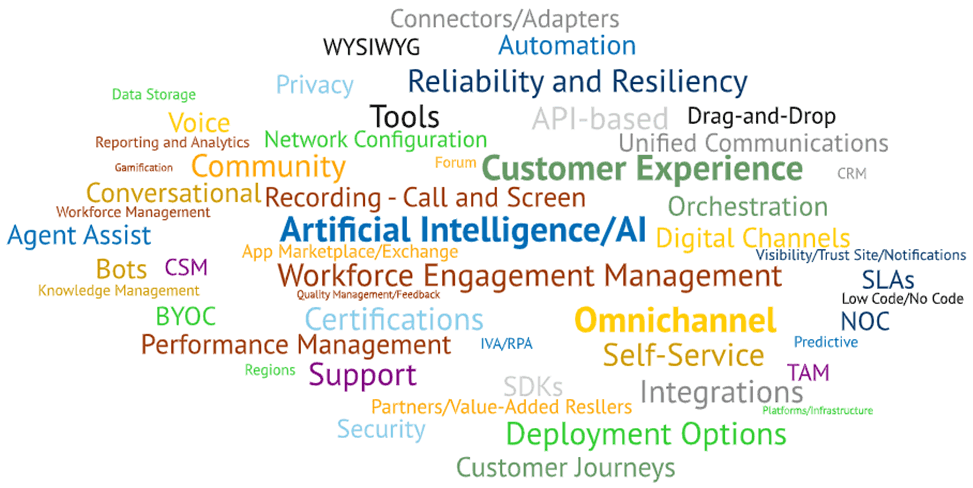The “state-of-the-market” is exciting; make thoughtful decisions to reap the rewards
I bet you are interested in the “state-of-the-market” of contact center technology and eager to see what it can do for your center. You may probe vendor websites or attend webinars to get a handle on what’s new and interesting. You may read analyst reviews and the latest articles. So much exciting technology! Broad themes quickly emerge. Cloud solutions offer a variety of options and flexibility about how you deploy and what you license. Full suites of Workforce Engagement Management (WEM) with workforce management (WFM), quality monitoring (QM), screen recording, and analytics entice as they have become accessible to all sizes of centers.

But you may also wonder, is your impression that everyone is doing omnichannel Artificial Intelligence (AI) with a focus on the customer experience accurate? AI can touch many technology elements – e.g., self-service/bots, workforce optimization, analytics, desktop tools such as knowledge management (KM)/agent assist. But AI success requires trained resources (internal or external) with a focus on analysis and optimization.
And important decisions impact outcomes. One of the biggest you’ll make centers on whether to purchase point solutions versus suites with integration across tools. It is a strategic decision for which a lack of strategy generally defaults to point solutions. There may be compelling reasons to pursue specific capabilities with specialty vendors. Just make sure you find out how they will integrate with your other elements for administration, data access, user interfaces, etc. Think of use cases or scenarios – e.g., what a customer does, how an agent succeeds, how a supervisor manages performance, how an analyst or administrator does their job. And think about all the channels the customer may use and how you will manage the customer and agent experiences end-to-end. Consider self-service, assisted service, reporting and analytics, and WFM and QM.
Other key decisions address functional overlap such as customer relationship management (CRM) and the contact center solution’s ability to track contact history, agent assist vs. KM, and the role speech analytics can play in agent assist. And one of my favorites – WEM – demands that you think about all the functional needs for WFM, QM, Analytics, performance management. The broader your needs, the more you will appreciate the value of the suite – for admin, omnichannel, and integrated user interfaces.
As you pursue cloud solutions you will find the vendors are part of an “ecosystem” with their partners, who offer additional products and services. The biggest players have an active “marketplace” that includes specialized applications and services that leverage cloud solutions’ openness through APIs. You may find just what you need for applications in your vertical market, integration with your desktop applications, or value-added capabilities to enable your vision for agents and customers.
Don’t forget to get into the weeds a bit about their architecture (and remember CC leaders, this is why even with cloud solutions, your IT friends are part of the team!). Discussions should include:
- Where things reside (e.g., AWS, Azure, their own data centers) and how they are managed
- How they handle resiliency/reliability, failover processes and impacts, and maintenance
- What options they support for network connectivity – vendor as the carrier or Bring Your Own Carrier (BYOC)
Make sure that your cloud vendors “check the boxes” for security and compliance (e.g., HIPAA, PCI), manage the infrastructure, commit to Service Level Agreements (SLAs) for reliability and resiliency, and offer robust APIs to enable integration (pre-built or customized). Key factors to explore include their certifications for your industry-specific needs, the SLA they offer (e.g., 99.99% uptime), response and resolution commitments, and remediation if they don’t hit it.
For those of you pursuing a new “phone system” at the same time as your contact center technology, take stock of what you have, define a clear strategy, and select Unified Communications (UC) with an eye toward your CC plans, including call flows, level of integration needed, and use cases between users. Some CC vendors partner with Microsoft for Teams integration, Zoom, etc. Some vendors (or VARs) provide UC and CC.
A “sandbox” is one more thing you may want to explore if you plan to do significant integration and customization, or have development, testing/QA, and/or training environments for other applications. Most cloud vendors enable you to set up these separate environments within the same “instance” and offer tools to promote to production – but never assume!
If you want to dive deeper into these “state-of-the-market” considerations, Contact us for assistance.
